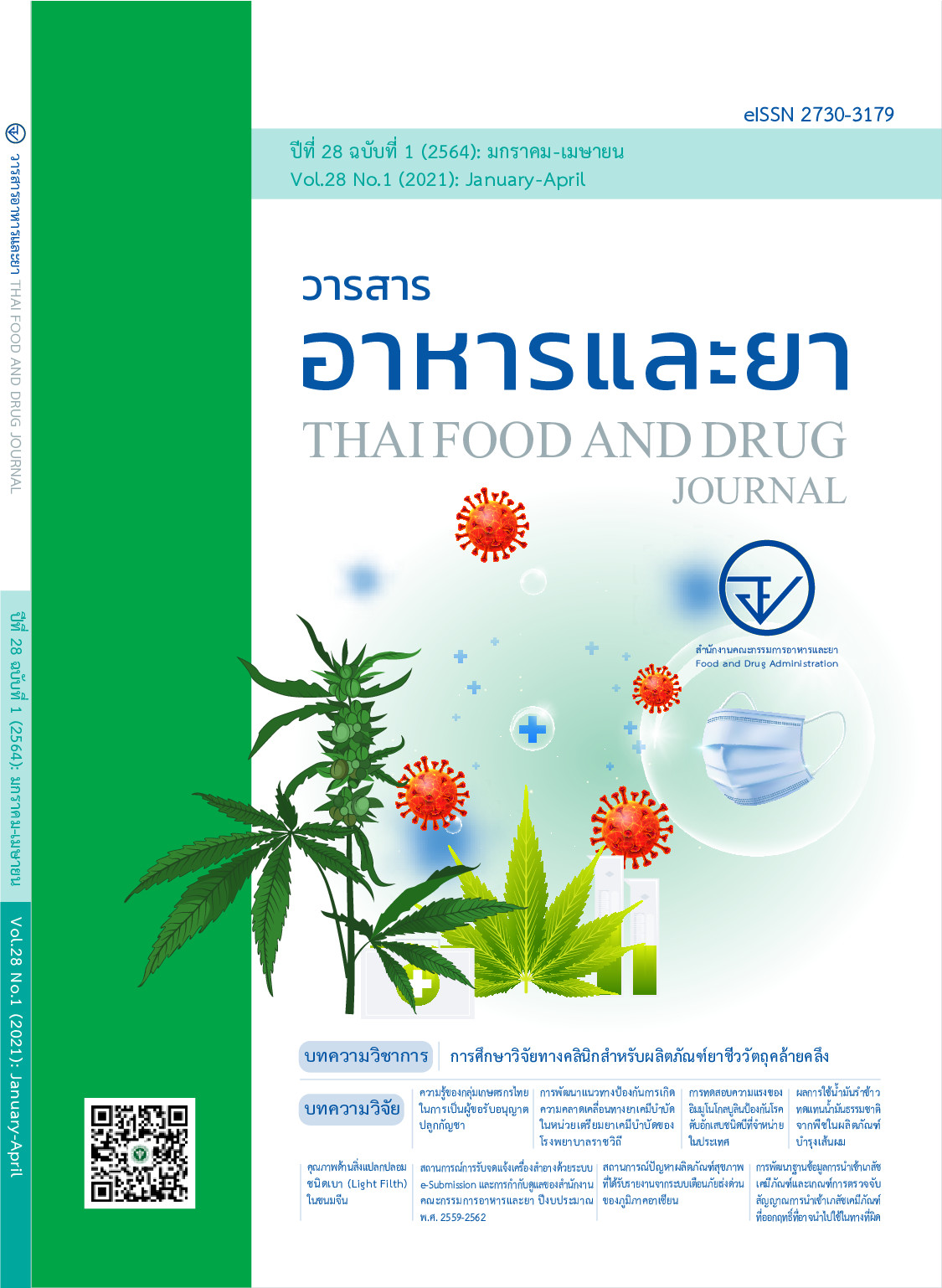สถานการณ์การรับจดแจ้งเครื่องสำอางด้วยระบบ e-Submission และการกำกับดูแลของ สำนักงานคณะกรรมการอาหารและยา ปีงบประมาณ พ.ศ. 2559-2562
Main Article Content
บทคัดย่อ
ความสำคัญ: การรับจดแจ้งเครื่องสำอางด้วยระบบอัตโนมัติพบปัญหาความคลาดเคลื่อนภายหลังผลิตภัณฑ์ออกสู่ตลาด
วัตถุประสงค์: เพื่อศึกษาความชุกของการรับจดแจ้งเครื่องสำอางด้วยระบบ e-Submission ของสำนักงานคณะกรรมการอาหารและยา (อย.) ในปีงบประมาณ พ.ศ. 2559-2562 ประเมินสถานการณ์และวิเคราะห์ปัญหาการรับจดแจ้งภายใต้ พ.ร.บ.เครื่องสำอาง พ.ศ. 2558 และศึกษาผลการดำเนินคดี วิเคราะห์สาเหตุและลักษณะของเครื่องสำอางที่ผิดกฎหมายหลังได้รับจดแจ้ง ในกลุ่มที่ถูกเพิกถอนใบรับจดแจ้งและกลุ่มที่ถูกประกาศผลวิเคราะห์เครื่องสำอาง
วิธีการวิจัย: เก็บข้อมูลจากฐานข้อมูลการจดแจ้งเครื่องสำอางของ อย.
ผลการศึกษา: การรับจดแจ้งเครื่องสำอางใน 4 ปี มีคำขอทั้งสิ้น 815,627 รายการ เป็นการอนุมัติจดแจ้งผลิตร้อยละ 44.12 และนำเข้าร้อยละ 34.53 มีการอนุมัติสูงสุดในปี 2560 จำนวน 208,461 รายการ (ร้อยละ 90.24) และต่ำสุดในปี 2561 จำนวน 136,781 รายการ (ร้อยละ 67.13) โดยในปีที่อนุมัติต่ำสุดนั้น พบการยกเลิกและเพิกถอนสูงสุดจำนวน 92,960 และ 933 รายการ (ร้อยละ 67.96 และ 0.68) ตามลำดับ ผลการดำเนินคดีภาพรวม 1,009 รายการ พบฉลากไม่ระบุผู้ผลิต หรือที่ตั้งไม่ตรงตามที่จดแจ้งร้อยละ 99.21 ไม่ได้ผลิตตามสถานที่ผลิตที่จดแจ้งไว้ หรือไม่มีสภาพเป็นสถานที่ผลิต ร้อยละ 97.22 รวมทั้งตรวจพบสารห้ามใช้ ร้อยละ 2.9 เมื่อจำแนกการดำเนินคดีในกลุ่มที่ถูกเพิกถอนใบรับจดแจ้งจำนวน 982 รายการ พบว่า เป็นผู้ประกอบการประเภทบุคคลธรรมดาร้อยละ 92.87 เป็นผลิตภัณฑ์เดี่ยวร้อยละ 99.90 มีเครื่องสำอางที่ถูกเพิกถอน 3 อันดับแรกคือ ผลิตภัณฑ์บำรุงผิว สบู่ และผลิตภัณฑ์ป้องกันแสงแดด ร้อยละ 59.06 24.95 และ 8.86 ตามลำดับ และยังพบเครื่องสำอางที่บรรจุในหลอดแก้วขนาดเล็กคล้ายหลอดยาฉีด 1 รายการ (ร้อยละ 0.1) ส่วนการดำเนินคดีในกลุ่มที่ถูกประกาศผลวิเคราะห์เครื่องสำอางทั้งสิ้น 27 รายการ ทั้งหมดเป็นการจดแจ้งผลิต สาเหตุพบสารห้ามใช้ร้อยละ 100.00 และฉลากไม่ถูกต้องร้อยละ 74.10 ผู้กระทำผิดส่วนใหญ่เป็นบุคคลธรรมดา ในขณะที่เป็นนิติบุคคลหนึ่งในสี่คิดเป็นร้อยละ 25.93 เครื่องสำอางที่พบเป็นผลิตภัณฑ์เดี่ยวร้อยละ 88.89 โดยเป็นเครื่องสำอางที่ใช้กับบริเวณผิวหน้าและผิวกายร้อยละ 85.19 และ 14.81
สรุป: การรับจดแจ้งเครื่องสำอางด้วยระบบ e-Submissionในรอบ 4 ปี พบปัญหาใหญ่หลังผลิตภัณฑ์ออกสู่ตลาดในเรื่องการจดแจ้งเป็นเท็จ และฝ่าฝืนกฎหมายเกี่ยวกับสถานที่ ดังนั้นจึงมีข้อเสนอให้ อย. ควรดำเนินการ (1) เน้นกระบวนการคัดกรองตั้งแต่ต้นน้ำให้ความสำคัญกับมาตรฐานของสถานที่ผลิตหรือนำเข้าเครื่องสำอางที่มีคุณภาพได้มาตรฐานและปลอดภัย รวมทั้งเน้นเฝ้าระวังสถานที่ที่เคยพบปัญหาหรือจัดว่าเป็นกลุ่มเสี่ยง (2) ปรับหลักเกณฑ์ให้ยื่นฉลากหรือภาพถ่ายผลิตภัณฑ์โดยเฉพาะกลุ่มเสี่ยงผิดกฎหมายก่อนสู่ตลาด เพื่อเป็นฐานข้อมูลไว้ตรวจสอบหลังการรับจดแจ้ง
Article Details

อนุญาตภายใต้เงื่อนไข Creative Commons Attribution-NonCommercial-NoDerivatives 4.0 International License.
เอกสารอ้างอิง
กรมพัฒนาธุรกิจการค้า. ธุรกิจผลิตเครื่องสำอาง [อินเทอร์เน็ต]. นนทบุรี: กรม; 2560 [เข้าถึงเมื่อ 21 ต.ค. 2562]. เข้าถึงได้จาก: https://www.dbd.go.th/download/document_file/Statisic/2560/T26/T26_201708.pdf
กรมพัฒนาธุรกิจการค้า. ธุรกิจขายส่งเครื่องสำอาง [อินเทอร์เน็ต]. นนทบุรี: กรม; 2558 [เข้าถึงเมื่อ 21 ตุลาคม. 2562]. เข้าถึงได้จาก: https://www.dbd.go.th/download/document_file/Statisic/2558/T26_201503.pdf
กระทรวงพาณิชย์. ข้อมูลสถิติมูลค่าการส่งออกเครื่องสำอาง สบู่ และผลิตภัณฑ์รักษาผิวหน้า [อินเทอร์เน็ต]. นนทบุรี: กระทรวง; 2562 [เข้าถึงเมื่อ 20 ต.ค. 2562]. เข้าถึงได้จาก: http://tradereport.moc.go.th/Report/Default.aspx?Report=MenucomTopNRecode&Option=3&Lang= Th&ImExType=1&comcode=329000000
สำนักงานคณะกรรมการอาหารและยา. พระราชบัญญัติเครื่องสำอาง พ.ศ. 2558. ราชกิจจานุเบกษา เล่มที่ 132, ตอนที่ 86 ก (ลงวันที่ 8 กันยายน 2558).
สำนักงานคณะกรรมการอาหารและยา. ข่าวแจก อย.: รับจดแจ้งเครื่องสำอางด้วยระบบอัตโนมัติ สะดวก ง่าย ไม่จำกัดจำนวน ประมวลผลทันที [อินเทอร์เน็ต]. นนทบุรี: สำนักงาน; 2560 [เข้าถึงเมื่อ 20 ต.ค. 2562]. เข้าถึงได้จาก: http://pca.fda.moph.go.th/public_media_detail.php?id=2&cat=50&content_id=787
อภิษฐา ทรัพย์ประเสริฐ, จันทรรัตน์ สิทธิวรนันท์. การประเมินความคลาดเคลื่อนภายหลังออกสู่ตลาดของผลิตภัณฑ์เครื่องสำอางที่ได้รับการจดแจ้งโดยระบบการจดแจ้งอัตโนมัติ. วารสารอาหารและยา 2562;1(26):23-35.
รุ่งดารา เนียมโภคะ, สุรศักดิ์ เสาแก้ว. การศึกษาสถานการณ์ของสถานที่ผลิตเครื่องสำอางและศักยภาพของผู้ผลิตเครื่องสำอางในประเทศไทย พ.ศ. 2561.อาหารและยา 2562;3(26):54-67.
สำนักงานคณะกรรมการอาหารและยา. ข่าวแจก อย.แจงปฏิบัติหน้าที่เข้มเอาผิดทางกฎหมายกับบริษัทเมจิกสกิน จำกัด มิให้หลอกลวงผู้บริโภค [อินเทอร์เน็ต]. นนทบุรี: สำนักงาน; 2561 [เข้าถึงเมื่อ 20 ต.ค. 2562]. เข้าถึงได้จาก:http://pca.fda.moph.go.th/public_media_detail.php?id=2&cat=50&content_id=1267


